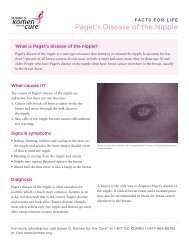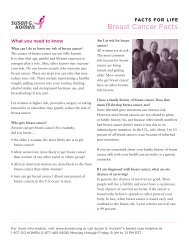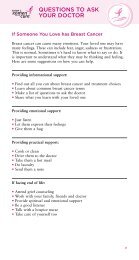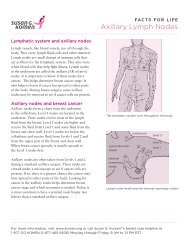Breast Self-Awareness Messages - Susan G. Komen for the Cure
Breast Self-Awareness Messages - Susan G. Komen for the Cure
Breast Self-Awareness Messages - Susan G. Komen for the Cure
Create successful ePaper yourself
Turn your PDF publications into a flip-book with our unique Google optimized e-Paper software.
<strong>Breast</strong> <strong>Self</strong>-<strong>Awareness</strong> <strong>Messages</strong>1. Know your risk9 Talk to your family to learn about your familyhealth history9 Talk to your doctor about your personal risk ofbreast cancer2. Get screened9 Ask your doctor which screening tests are right <strong>for</strong>you if you are at a higher risk9 Have a mammogram every year starting at age 40if you are at average risk9 Have a clinical breast exam at least every 3 yearsstarting at age 20, and every year starting at age 409 Sign up <strong>for</strong> your screening reminder atkomen.org/reminder3. Know what is normal <strong>for</strong> you9 See your health care provider if you notice any of <strong>the</strong>sebreast changes:• Lump, hard knot or thickening inside <strong>the</strong> breast or underarm area• Swelling, warmth, redness or darkening of <strong>the</strong> breast• Change in <strong>the</strong> size or shape of <strong>the</strong> breast• Dimpling or puckering of <strong>the</strong> skin• Itchy, scaly sore or rash on <strong>the</strong> nipple• Pulling in of your nipple or o<strong>the</strong>r parts of <strong>the</strong> breast• Nipple discharge that starts suddenly• New pain in one spot that does not go away4. Make healthy lifestyle choices9 Maintain a healthy weight9 Add exercise into your routine9 Limit alcohol intake9 Limit menopausal hormone use9 <strong>Breast</strong>feed, if you canFor more in<strong>for</strong>mation visit our website or call ourbreast care helpline.www.komen.org 1-877 GO KOMEN (1-877-465-6636)
Know What is Normal For YouThe signs of breast cancer are not <strong>the</strong> same <strong>for</strong> all women.It is important to know how your breasts normally look andfeel. If you notice any change, see your health care provider.Changes that should be reported include:• Lump, hard knot orthickening inside <strong>the</strong> breastor underarm area• Swelling, warmth, rednessor darkening of <strong>the</strong> breast• Change in <strong>the</strong> size orshape of <strong>the</strong> breast• Dimpling or puckering of<strong>the</strong> skin• Itchy, scaly sore or rashon <strong>the</strong> nipple• Pulling in of your nippleor o<strong>the</strong>r parts of <strong>the</strong> breast• Nipple discharge thatstarts suddenly• New pain in one spot thatdoes not go awayAll images are copyrighted, ©2014 <strong>Susan</strong> G. <strong>Komen</strong> ® . Use of images prohibited without prior written permission.<strong>Komen</strong> does not provide medical advice. ©2014 <strong>Susan</strong> G. <strong>Komen</strong> ® Item No. KOMEED200600, English 4/14








